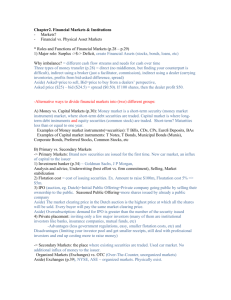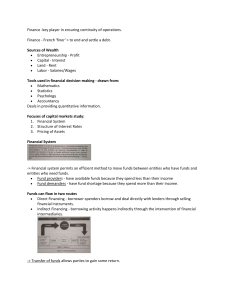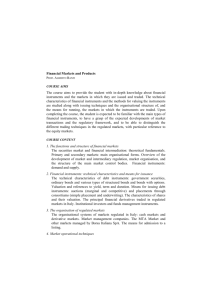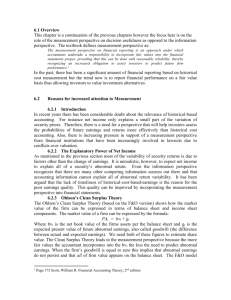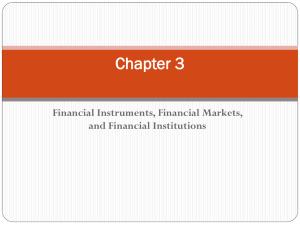Basic Concepts about Financial Market
advertisement
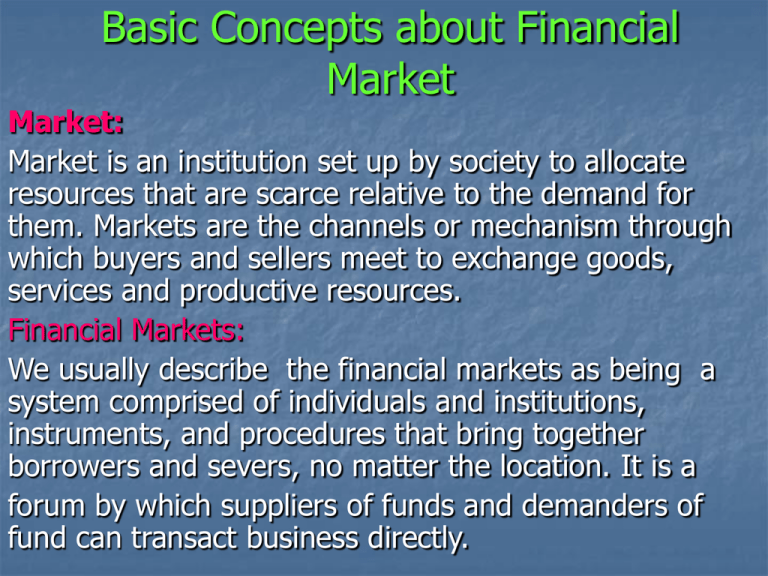
Basic Concepts about Financial Market Market: Market is an institution set up by society to allocate resources that are scarce relative to the demand for them. Markets are the channels or mechanism through which buyers and sellers meet to exchange goods, services and productive resources. Financial Markets: We usually describe the financial markets as being a system comprised of individuals and institutions, instruments, and procedures that bring together borrowers and severs, no matter the location. It is a forum by which suppliers of funds and demanders of fund can transact business directly. Functions Performed by Financial Market a) Savings Function – Bonds, stocks and other financial claims sold in the money and capital markets provide a profitable, relatively low-risk outlet for the public’s savings, which flow through the financial markets into investment so that more goods and services can be produced (i.e., productivity will rise), increasing the world’s standard of living. The financial market enabled us to consume amounts different than our current incomes. In other word it allows us to transfer income through time by either saving or borrowing. Functions Performed by Financial Market b) Wealth Function – For those businesses and individuals choosing to save, the financial instruments sold in the money and capital markets provide an excellent way to store wealth until funds are needed for spending. c) Liquidity Function – For wealth stored in financial instruments, the global financial marketplace provides a means of converting those instruments into cash with little risk of loss. Thus, the world’s financial markets provide liquidity for savers who hold financial instruments but are in need of money. Functions Performed by Financial Market d) Credit Function – Financial markets furnish credit to finance consumption and investment spending. Credit consists of a loan of funds in return for a promise of future payment. Consumers, Businesses, and Governments need credit for several reasons. e) Payments Function – Financial markets also provide a mechanism for making payments for goods and services. Certain financial assets, bank checking account, payment order, demand draft, plastic credit card, ATM card and some other instruments serve as a medium of exchange in making payments. Functions Performed by Financial Market f) Risk Protection Function – The financial markets around the world offer businesses, consumers, and governments protection against life, health, property and income risks. This is accomplishing, first of all, by the sale of different types of insurance policies. g) Economic Stabilization: in recent decades, the financial markets have been the principal channel through which government has carried out its policy of attempting to stabilize the economy and avoid inflation. By manipulating interest rates and the availability of credit, government can affect the borrowing and spending plans of the public, which in turn, influence the growth of jobs, production and policies. Classifications of Financial Markets Two major Financial Markets are1. The Money Market: The money market is created by a financial relationship between suppliers and demanders of short-term funds (funds with maturities of one year or less). 2. The Capital Market: A market that enables suppliers and demanders of long-term funds to make transactions. Included are securities issues of business and government. The Money Market Instruments Treasury Bill- Sold to institutional investors by the Treasury (in BD it is the Treasury of Bangladesh Bank) to finance the government’s short term requirements for which maturity normally last from 91 days to 1 year. Repurchase Agreements- Used by banks to adjust reserves. Here banks sell investments with repurchase promise for very short time. The Money Market Instruments Bankers’ Acceptances- Firm’s promise to pay; guaranteed by a bank. Usually low degree of risk involved here if bank is strong and reputed. Negotiable Certificates of Deposits (CDs)- Issued by major money-center commercial banks to large investors. This instrument is riskier than Treasury bills. Commercial Paper- Issued by large, financially secure firms to large investors. It has law default risk. The Capital Market Instruments: Corporate Bonds- Issued by corporations to individuals, institutional investors, and corporations. Risk depends on the company and normally riskier than government bonds, but not as risky as stock. Example, IBBL public bond. Preferred Stock- A special form of ownership having a fixed periodic dividend that must be paid prior to payment of any common stock dividends. In Bangladesh companies are not allowed to offer preferred stock. The Capital Market Instruments Common Stock- Units of ownership, or equity in a corporation. It is issued by corporations to individuals and institutional investors. Common stock holders earn a return by receiving dividends or by capital gain through realizing increases in share price. Classification of Capital Market Primary Market: The primary market is for the trading of new securities never issued before. Its principal function is raising financial capital to support new investment in buildings, equipment, and inventories or even to pay off the previous debts. Investors engage in a primary-market transaction when they purchase shares of stock just issued by a company. Classification of Capital Market Secondary Market: The secondary market deals in securities issued previously. The proceeds from any share sold in the secondary market does not go to the corporations directly. But it creates a market for the sellers to trade their ownerships. Thus, its chief function is to provide liquidity to security investorsthat is, provide an avenue for converting financial instruments into ready cash. The volume of trading in the secondary market is far larger than the primary market. Security Exchange Securities Exchange – Organizations that provide the marketplace in which firms can raise funds through the sale of new securities and purchasers can resell securities. The best-known organized exchanges in the world include the New York Stock Exchange (NYSE), the American Stock Exchange (AMEX), the London Stock Exchange, the Hong Kong Stock Exchange, and the Singapore Stock Exchange. Some Other Types of Market Debt Markets are the markets where loans are traded. In this case debt instruments are necessary for trading which represent as a contract that specifies the amounts, as well as the times, a borrower must repay the funds provided by lender. The borrower can be an individual, a government or a business. Mortgage Markets deal with loans on residential, commercial and industrial real estate, and on farmland. Some Other Types of Market Consumer Credit Markets involve loans on autos and appliance, as well as loans for education, vacation, marriage and so forth. A Spot Market is one in which assets or financial services are traded for immediate delivery (usually within one or two business days). Some Other Types of Market A Futures and Forward Market is designed to trade contracts calling for the future delivery of financial instruments. Over the Counter Market: If a security is not traded in an organized exchange, it is customary to say it is traded over the counter (OTC). The over the counter market is an intangible organization that consists of a network of brokers and dealers around the country. The Role of Securities Exchanges: Securities exchanges create continuous markets in which firms can obtain needed financing. They also create efficient markets that allocate funds to their most productive uses. This is especially true for securities that are actively traded on major exchanges, where the competition among wealth- maximizing investors determine and publicize the prices. Financial Institutions and Fund Transfer system 1. A Direct Transfer of money and securities occurs when a business sells its stocks or bonds directly to savers (investors), without going through any type of financial institution. In Bangladesh, government owned oil and gas companies went directly to the share market without going through any financial institutions as guarantors. Financial Institutions and Fund Transfer system 2. Through an Investment Banking House funds are also transferred among different sectors. In this case they serve as an intermediaries or middlemen and facilitate the issuance of securities. 3. Transfer can also be made through other Financial Intermediaries such as a bank or a mutual fund. Capital Market Efficiency An efficient capital market is one in which the prices of securities “fully reflect” all available information. The reflection or reaction of market prices to new information should be instantaneous and unbiased. Efficient Capital Market (Cont.) A market which truly reflects the demand and supply equilibrium price of the stocks. S share price D O Number of Share Traded Types of Capital Market Efficiency 1. Weak form efficiency- which implies that the information contained in the past sequence of prices of a security is fully reflected in the current price of that security. 2. Semi-strong form efficiency- which implies that all publicly available information is fully reflected a security’s market price, including information about past prices and volume. Types of Capital Market Efficiency 3. Strong from efficiency- which implies that all information, whether public or private, is fully reflected in a security’s price.
